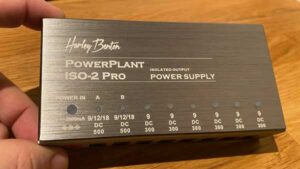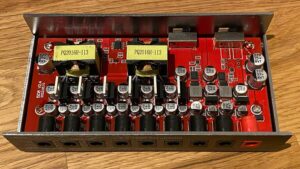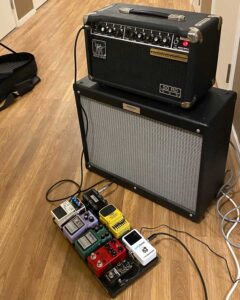For those who may not know: Harley Benton is the ”house brand” for German music retailer Thomann, and has long been associated with cheap and cheerful (but mostly cheap) stuff. The last few years, though, they seem to have stepped up their game. The ”Fusion” series guitars are reportedly surprisingly good, and wouldn’t be out of place in most guitar collections. I was naturally interested when I saw their new ”Pro” line of power supplies. As with most ”house brands”, many of their products are sourced from OEM manufacturers, who manufacture the same products for several brands. Such is the case with this particular power supply as well – it is also available as the Vitoos ISO8. The Vitoos DD8-SV2 is virtually the same, but with slightly higher stated current capacity (and a slightly more powerful adapter to power it).
Anyway, my interest was piqued. Will it be properly isolated, as they claim? Will it hold up over time? I decided to give it a shot when putting together a pedalboard for a friend. This was to be a ”fly rig” board (small enough to go as carry-on on flights), so weight and size were important factors.
Size-wise, the ISO-2 Pro was almost perfect, at 140x70x30mm. And weight was not an issue either – it weighs next to nothing. Not that it is flimsy, I should add. The brushed steel box seems like it could take some beating, in fact. The power supply was installed under a small and well populated Pedaltrain board, and I did end up having to raise the back just a hair, to get it to fit. I know there are riser kits for Pedaltrains available, but the idea here was to not tilt the board too much (neither of us likes that style of board, as it turned out), so I ended up just shimming the stock plastic feet. Side note: I wish I knew how to drill out pop rivets without the bits on the inside coming loose (and without also making the hole larger). Maybe there is a way, but I failed in that endeavour. And since the Pedaltrain boards are welded shut, there’s no way to get the remains of the pop rivets out. So now the board can double as maraccas… 🙂
I digress… Looking inside the unit, we can clearly see the relation to other units – the board says ”ISO8”, which is a Vitoos product. So, most likely, anything I have to say about this Harley Benton unit would go for the two Vitoos units (ISO8 and DD8-SV2) as well.
I was able to verify that all outputs are isolated from each other – no physical connection was detected between the outputs (either on the + or – side). So far so good. And the output voltages were steady at slightly above 9 volts DC for all outputs. In the 12 and 18 volt positions, the two switchable outputs stayed at just a hair above the stated voltage.
One thing I didn’t like was the power supply – or rather, the cable that connects the ”wall wart” to the ISO-2 Pro. That cable seems far too thin and flimsy to hold up to any serious touring. I did end up securing it, with proper strain relief, to the board, to avoid having to reach under the board to plug/unplug it. But I will look into replacing the whole cable for something more substantial. Of course, if you prefer having a proper mains cable to the board (rather than a separate power supply), this unit won’t be for you. In that case, I’d look into the PowerPlant AC series instead. For this build, those weren’t suitable due to the size constraints.
The 9vDC outputs are rated for 300mA each, while the two switchable 9/12/18vDC outputs are rated for 500mA each. I did not get the opportunity to do a load test, so I can’t say how well the stated current capacity holds up, how the outputs behave when loaded close to the limit and where the practical max capacity (before hum and ripple starts to become too obvious) is. However, the stated overall capacity is 2000mA (18 watts at 9vDC), so at no point will you be able to go all out on all outputs. In most cases, though, that won’t be an issue. You’d have a hard time getting near the limit, unless you try to power a board full of high current Strymons etc.
As always, it’s not possible to say that a specific power supply will work for everyone, in every situation. And there are definitely things I didn’t have time to test with this one – most importantly where its upper power limits are, and how it behaves at that end of the spectrum. So this is not a full-on recommendation, just yet. But I will say that with this setup and these particular pedals, the Harley Benton ISO-2 Pro did not introduce any additional noise/hiss/hum. We decided to run the JHS Andy Timmons pedal at 18vDC, and left the other switchable output open for the future. The rig stayed dead quiet, which seemed promising. Time – and the rigours of gigs and touring – will tell if it holds up. However, the rig did sound glorious echoing through the corridors at my workshop! 🙂
Summary:
Pros: Fully isolated outputs, with no AC mains power on the pedalboard itself to cause hum. Two outputs switchable 9/12/18vDC. No noise that I could detect. Small and light, and it’s cheap!
Cons: Thin and flimsy DC cable from the power supply that powers the ISO-2 Pro. Each output may or may not be able to provide its stated current capacity, but either way you can’t max out all 8 – the combined load must be below 2000mA total.
Unknown/not tested/caveats: I have not done a load test to see how the supply behaves as the load nears the stated capacity (if the voltage stays steady all the way to the end, or if it chokes at some point). So YMMV – you might find that using one of the 300mA outputs for a 300mA max pedal will result in noise. Or it might be just fine. For this board, where none of the pedals draw above 70-80mA, it worked just fine.


